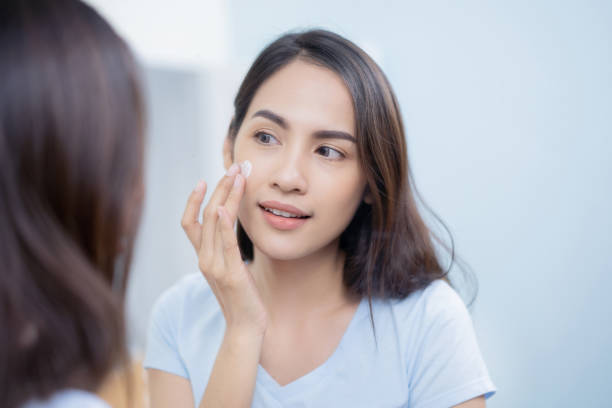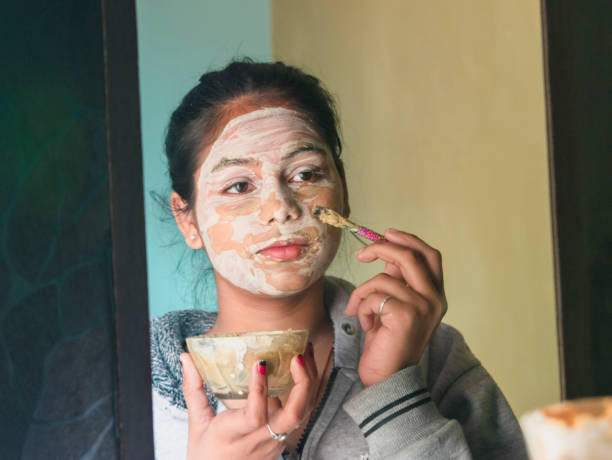Do you have oily skin, continually feel the need to wash your face and wish you could find a way to make those pores looks smaller?
You and millions of other people with oily skin are in the same boat. Mind you, oily skin does not get lines and wrinkles as quickly or as deeply as people with dry skin… So that’s got to be a bonus – although it probably doesn’t make you feel any better about your oily skin problem, does it.
Often, oily skin is associated with acne, however, here we will focus on the classic oily skin type and look at the causes and solutions for oily skin.
Oily skin may be the result of several causes:
- Hereditary
- Dietary
- Hormone levels; Age (puberty/adolescence, Menopause/change of life, etc); Birth control pill; Other medications
- Pregnancy
- Cosmetics and/or skin care products you’re currently using
- Climate
Oily skin may well be in your genes. People from Mediterranean, some Asian and middle-Eastern countries may inherit oily skin from their parents. This is a genetic mechanism to help protect their skin from the high radiation of the sun. However, if you have inherited this skin type, but do not live in the climate it was designed for, this can be a problem and needs to be addressed.
Diet can be both the cause as well as the solution for oily skin. Eating greasy, oily foods will eventually produce oily skin. It is the diet’s fat (and sugar which is converted to fat) content that ends up on the surface of your skin and that is a relatively easy cause to fix. Fix your diet and you’ll fix your oily skin.
Hormonal changes especially during the teenage and change of life years can cause oily skin, often associated with acne. Similarly, pregnancy, during which your hormones change dramatically, may cause oily skin. Usually this is resolved soon after giving birth, menopause has passed or once a teenager’s body reaches maturity.
Often however, the very products you are using are the reason for your oily skin. This can be cosmetic products or skin and personal care products.
Personal products such as soaps are particularly ‘hazardous’. The reason soap is a no-no when it comes to oily skin is that the soap you use to wash your face will initially remove the oil, but it will also dry out your skin causing your skin to over-react and over produce oil which is then secreted onto the skin’s surface and oops, you have oily skin again. This is a condition known as reactive seborrhoea.
Another factor that can lead to oily skin is the climate in which you life. A humid, hot climate may cause your skin to become oily.
Many people have oily areas in one area of their face, but other areas may well be normal or dry. This is known as combination skin. Often the oily area is in the
T-Zone. That is the area covered by your forehead, nasal section and chin. You may however only have oily skin in one of these areas or elsewhere on your face. Irrespective of where the oily skin is, you’ll need to address the cause in order to fix it.
How to fix your oily skin
Okay, you can’t do much about the genes you’ve inherited, or the fact you’re pregnant or going through a change in hormonal balance. But you can still help your skin to work at a more ‘normal’ level. You can influence the oiliness of your skin and you can take steps to normalize your skin’s oil secretions.
Let’s take a step-by-step look at how you can normalize your skin.
Basic steps applicable to all causes of oily skin type:
- Wash your face no more than 2x per day. If you do, you are likely to over stimulate your skin and this will cause it to produce more oil – not the result you want.
- Use hot water to wash your face. Hot water is best to dissolve oil. Cold and warm water just doesn’t work as well.
- Do NOT use commercial soaps to wash your face. These types of soaps will dry out your skin and this again will result in your skin producing more oil to protect itself against the drying effect caused by the soap.
- Eat a healthy diet. What’s a healthy diet? Simple, use unprocessed, fresh fruits and vegetables; do not use foods that have been pre-prepared and/or conserved; do not eat junk food. Stay away from rich, fatty meals.
- Drink plenty of clean fresh water (2 liters minimum per day).
The next step is to choose the right type of skin care products. Yes, it’s a little more difficult than just buying a cleanser and moisturizer that smell nice and hope they’ll help your oily skin.
- Only purchase natural and organic skin and personal care products. There are many reasons for this, but suffice it to say – why put more junk into your body than is necessary?
- Look closely at the ingredients. You will need to look for ingredients that will benefit your oily skin type. So, look for the following essential oils:
- Lemon
- Lemon-scented Tea Tree,
- Calendula,
- Lavender,
- Jojoba,
- Avocado,
- Bergamot
- Orange Blossom,
- Rosemary,
- Witch hazel,
- Juniper Berry,
- Peppermint,
- Grapefruit,
- Niaouli and
- Sweet Orange.
Many of these essential oils help specifically in normalizing sebum production.
One of the biggest problems with oily skin is that the excessive oil being produced tends to clog up the pores and cause bacterial growth (Acne) and/or oxidation of the oil (blackheads).
So, looking at this as a 3-step process:
1. Follow a daily skin care regime:
- Cleanse your facial skin using hot water and/or a natural cleanser (alcohol free) that contains essential oils and herbs to help remove oxidized natural oils and make-up residues. This will leave your skin feeling fresh and clean.
- Use a natural toner to help remove any remaining cleanser and close the open pores. This prevents further loss of moisture and by closing the pores, this prevents bacteria and other microbes from entering the open pores.
- Even though your skin is oily, you should still use a light moisturizer that contains oils such as Jojoba or Avocado as their primary ingredient.
- There is one more thing you will need to do – Use a facial clay mask twice weekly. Use Green Clay as it is the most drawing of the clays and will most help oily skin. Then follow with the above cleansing, toning and moisturising.
2. Eat wholesome food and drink plenty of water.
3. Exercise
- This step is an important step because regular exercise will promote increased blood circulation helping to nourish your skin, while providing improved blood supply to the very surface of your skin. The perspiration (and consumption of additional water) will help to flush out toxins from your skin’s pores – but remember to increase the water consumption by at least 0.5 of a liter on days when you exercise.




